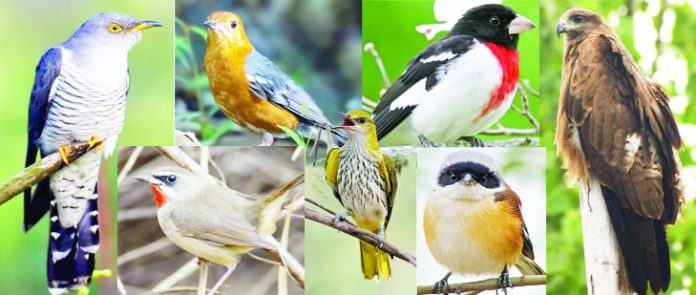Dr Jasbir Singh Sarna
The Kashmir valley is renowned for its natural beauty, replete with vibrant flora and a profusion of avian species. As one ascends the mountain ranges, the ecological composition is significantly influenced by factors such as temperature, precipitation, and humidity.
Elevation gain correlates with a temperature decrease. The resultant temperature zones, ranging from subtropical to arctic, significantly shape the vegetation and, consequently, bird habitats. Notably, avian species exhibit variations in size corresponding to the climate of their habitat, with birds from colder regions typically larger.
Mountain-dwelling birds have evolved larger lung capacities in response to these high-altitude conditions, distinguishing them from their lowland counterparts.
Among nature’s creations, humans stand as the most intellectually capable. This ingenuity has historically harnessed avian species for various purposes, exemplified by pigeons serving as messengers in both war and peace. Pigeons and doves symbolize peace, while vultures fulfill the essential role of scavenging, preventing environmental pollution by disposing of carrion. The ‘Chakki Raha’ bird benefits farmers by consuming agricultural pests like insects and weevils, while the ‘Tillier’ bird combats locust swarms, thus averting famine.
Migration is a vital aspect of avian life, especially for birds inhabiting northern regions. The imperative to migrate to warmer regions near the equator during winter arises from factors like diminishing daylight, scarcity of food due to snow cover, and the freezing of water sources.
Seasonal shifts in weather patterns also influence bird behavior. For instance, certain species like the Himalayan Laughing Musk migrate to lower altitudes during the winter months. Contrarily, some birds undertake inverse migrations, descending from higher elevations in winter and ascending in the summer months. Mountain migratory birds, such as Hindustani birds, wild chickens, Hindustani blue chats, and variegated plains muskrats, breed in the Himalayas and Kashmir but flock to the Nilgiris and neighboring South-West Indian mountains, traversing distances of 1,200 to 1,500 miles in winter.
The adaptability of these birds to varying environments throughout the year is a testament to their resilience. It is noteworthy that birds have been observed flying as high as 29,000 feet, emphasizing the profound impact of mountain ranges, vegetation, and local atmospheres on avian life and development.
Botanists note that the flora on the upper slopes of mountains is generally symmetrical. This topography supports various bird species, including ‘Laughing Thrushes,’ which flourish in high forest ecosystems up to 3,500 feet. Birds often migrate from one hill to another, seeking to align their lifestyles with the changing environment and, subsequently, find suitable habitats. Identification of birds hinges on their distinctive features, including beak, tail, plumage, and coloration. Birds disregard political boundaries, and when referring to Kashmiri birds, it encompasses those residing in both Indian and Pakistani-administered Kashmir.
Kashmir serves as a global symbol of pride, showcasing the beauty of nature and its avian inhabitants. However, the relentless urbanization and increased traffic in other cities are posing a threat to bird populations. Pollution-induced noise is causing birds to mimic artificial sounds, potentially leading to mating disruptions and a decline in new generations. Studies by ornithologists in England and New Zealand have documented the adverse effects of noise pollution on bird behavior and vocalizations. Birds learn their songs from older generations, much like humans acquire language from their parents. Hence, the alteration of these songs due to noise pollution poses a significant ecological concern.
Birds exhibit diverse habitat preferences, residing in mountain forests, lowland forests, or arid deserts. The Indian subcontinent, along with South-East Asia, ranks among the world’s six major biodiversity hotspots. The avifauna in Kashmir shares similarities with birds in the Indo-China region, thanks to the continuous mountainous terrain connecting the two areas. Presently, there are over a thousand bird species in the Indian subcontinent.
While Kashmir boasts unique avian species, some, such as the shikra, owl, and crow, are widespread globally. Notably, the most exquisite pheasants, members of the Chakor family, are exclusive to Kashmir and the Himalayan region. Bird classification entails the hierarchical structure of class, order, family, genus, and species, with subspecies identified when specific differences exist among birds in the same environment. Birds adapt to their habitats for vital activities such as feeding, nesting, and raising offspring, and these habitats vary from mountains to forests, dense thickets, or open plains.
Urban and rural regions in Kashmir host a variety of bird species, with crows, house crows, sparrows, and parrots prevalent in cultivated lands, while bulbuls, pigeons, and sunbirds are commonly found in parks and gardens. Kashmir also attracts a substantial number of migratory birds, with approximately 250,000 individuals of various species observed during the early 2000s. Some of these migratory birds have even started breeding in the region, further enriching its avian diversity.


